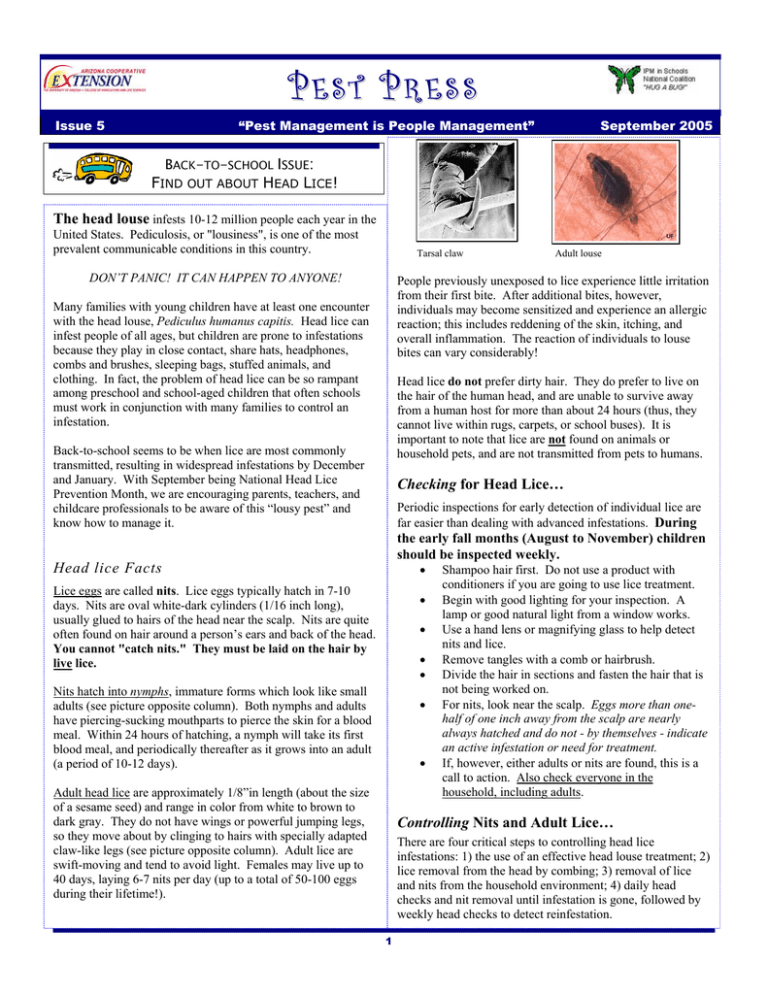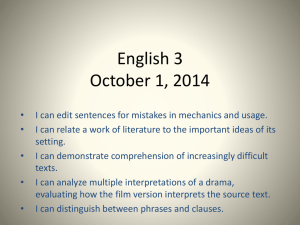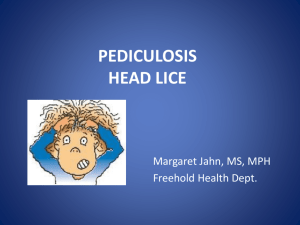P E S
advertisement

PEST PRESS Issue 5 “Pest Management is People Management” September 2005 BACK-TO-SCHOOL ISSUE: FIND OUT ABOUT HEAD LICE! The head louse infests 10-12 million people each year in the United States. Pediculosis, or "lousiness", is one of the most prevalent communicable conditions in this country. Tarsal claw DON’T PANIC! IT CAN HAPPEN TO ANYONE! Adult louse People previously unexposed to lice experience little irritation from their first bite. After additional bites, however, individuals may become sensitized and experience an allergic reaction; this includes reddening of the skin, itching, and overall inflammation. The reaction of individuals to louse bites can vary considerably! Many families with young children have at least one encounter with the head louse, Pediculus humanus capitis. Head lice can infest people of all ages, but children are prone to infestations because they play in close contact, share hats, headphones, combs and brushes, sleeping bags, stuffed animals, and clothing. In fact, the problem of head lice can be so rampant among preschool and school-aged children that often schools must work in conjunction with many families to control an infestation. Head lice do not prefer dirty hair. They do prefer to live on the hair of the human head, and are unable to survive away from a human host for more than about 24 hours (thus, they cannot live within rugs, carpets, or school buses). It is important to note that lice are not found on animals or household pets, and are not transmitted from pets to humans. Back-to-school seems to be when lice are most commonly transmitted, resulting in widespread infestations by December and January. With September being National Head Lice Prevention Month, we are encouraging parents, teachers, and childcare professionals to be aware of this “lousy pest” and know how to manage it. Checking for Head Lice… Periodic inspections for early detection of individual lice are far easier than dealing with advanced infestations. During the early fall months (August to November) children should be inspected weekly. Head lice Facts • Lice eggs are called nits. Lice eggs typically hatch in 7-10 days. Nits are oval white-dark cylinders (1/16 inch long), usually glued to hairs of the head near the scalp. Nits are quite often found on hair around a person’s ears and back of the head. You cannot "catch nits." They must be laid on the hair by live lice. • • • • Nits hatch into nymphs, immature forms which look like small adults (see picture opposite column). Both nymphs and adults have piercing-sucking mouthparts to pierce the skin for a blood meal. Within 24 hours of hatching, a nymph will take its first blood meal, and periodically thereafter as it grows into an adult (a period of 10-12 days). • • Adult head lice are approximately 1/8”in length (about the size of a sesame seed) and range in color from white to brown to dark gray. They do not have wings or powerful jumping legs, so they move about by clinging to hairs with specially adapted claw-like legs (see picture opposite column). Adult lice are swift-moving and tend to avoid light. Females may live up to 40 days, laying 6-7 nits per day (up to a total of 50-100 eggs during their lifetime!). Shampoo hair first. Do not use a product with conditioners if you are going to use lice treatment. Begin with good lighting for your inspection. A lamp or good natural light from a window works. Use a hand lens or magnifying glass to help detect nits and lice. Remove tangles with a comb or hairbrush. Divide the hair in sections and fasten the hair that is not being worked on. For nits, look near the scalp. Eggs more than onehalf of one inch away from the scalp are nearly always hatched and do not - by themselves - indicate an active infestation or need for treatment. If, however, either adults or nits are found, this is a call to action. Also check everyone in the household, including adults. Controlling Nits and Adult Lice… There are four critical steps to controlling head lice infestations: 1) the use of an effective head louse treatment; 2) lice removal from the head by combing; 3) removal of lice and nits from the household environment; 4) daily head checks and nit removal until infestation is gone, followed by weekly head checks to detect reinfestation. 1 1.) Head lice shampoos contain insecticides and if they 3.) What needs to be done in the home? Once an are not used properly they can be hazardous. Most over-thecounter products contain either pyrethrin or permethrin (NIX and Rid). Lindane, available with a prescription, has been associated with a variety of adverse reactions suffered both by people being treated and by people applying the treatment. Pyrethrin and permethrin are safer and more effective than lindane. infestation is detected, all clothes should be washed in hot soapy water. Pillowcases, sheets, blankets and other bedding material should also be washed and placed in the clothes dryer on the "high heat" cycle to kill the lice and their eggs. Any non-washable items should be dry cleaned or sealed in plastic bags and placed in the freezer at 50F or lower for 10 hours or more (a good option for headphones). Vacuuming the home will remove shed hair that has nits attached. When using a head louse shampoo, minimize body exposure by confining the insecticide to the head hair. Wash the infested person's hair in a basin or sink so insecticide residues do not reach other parts of the body. The person applying the treatment should wear rubber gloves. Never apply an insecticide to anyone who has open cuts, scratches, or inflammations, and never use these materials on infants without consulting a doctor. In all cases, follow label directions completely and carefully. 4.) Continue weekly head checks of the whole family. To find out about YOUR school’s policy and procedures for children discovered with lice, check with your school nurse’s office. Information taken from: Pollack, Richard J. August 2000. Harvard School of Public Health With pyrethrin and permethrin shampoos, lice should die within 10 to 30 minutes after treatment. If you find live lice after 30 minutes, resistance may be occurring and you should discontinue use of that product. Switch to a pyrethrin if you used permethrin the first time, or vice versa. Never resort to dangerous practices such as applying other insecticides, or materials such as kerosene! 9 If you want to avoid insecticides entirely, try using soap shampoos that contain coconut or olive oils. Begin with four shampoo applications, each about 3 days apart. Each successive shampooing kills newly-hatched nymphs. 2.) Special combs are needed for louse removal and will be effective in eradicating head lice infestations only if used diligently each day for up to two weeks. The LiceMeister™ comb is a great choice. Combing is critical to controlling head lice because 20 to 30% of lice can still be alive after shampooing with pyrethrin or permethrin based products. Note: using a lice comb to remove the insects can take up to several hours a day, depending on the thickness and curliness of the hair. • • • • • After removing tangles and dividing hair into manageable portions, comb hair from scalp to the end of the hair. Dip comb in a container of hot soapy water to drown lice and remove nits. Look through that same section of hair for remaining nits and lice. Repeat if necessary. Repeat all steps until all hair is systematically combed through. Clean nit removal comb with hot soapy water or soapy ammonia. An old tooth brush may help dislodge hair, nits and lice that may be caught in the teeth of the comb. Scherer, C. W., P. G. Koehler and F. M. Oi. August 1997. Head Lice. University of Florida: http://edis.ifas.ufl.edu. The National Pediculosis Association,® Inc.: http://www.headlice.org/ Arizona’s IPM in Schools Program IPM stands for Integrated Pest Management. It is an approach used by pest management experts who want high levels of pest control and low levels of chemical pesticides in the environment. Dr. Dawn Gouge, University of Arizona, has worked closely with Dr. Marc Lame from the School of Public and Environmental Affairs at Indiana University since 2000 to implement a highly effective model approach to IPM in Arizona’s Schools (the “Monroe IPM Model”). More than a dozen school districts in Arizona have volunteered to “do the right thing” by implementing this program, thereby impacting more than 250,000 children. Dr. Lame has written a book about the evolution of IPM in schools, and programs in Arizona are featured prominently in his book “A Worm in the Teacher’s Apple, Protecting America’s School Children from Pests and Pesticides”. This ground-breaking book illustrates the national problem of pesticide dependence and highlights the heroic actions of risk takers in our schools, industry, and regulatory community who are attempting to change this paradigm. This book is for those concerned about children and our environment – from all members of the school community and parents to health care professionals, policy makers, and pest management professionals. It is available online at www.pesticidesnotinschool.com. For more information on IPM in Schools in Arizona, contact Dawn Gouge or Jennifer Snyder, (520) 568-2273, dhgouge@ag.arizona.edu or jsnyder@ag.arizona.edu Few bugs are bad! More than 95% of all insect species are beneficial to humans. 2




